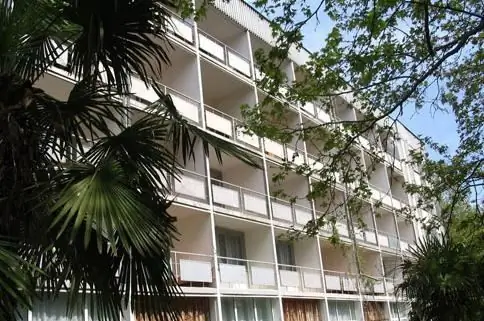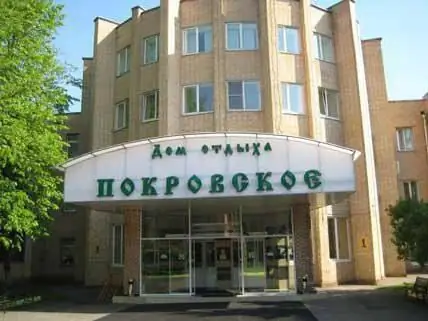- Author Harold Hamphrey [email protected].
- Public 2023-12-17 10:06.
- Last modified 2025-06-01 07:20.
Gostiny yards of Russia, like all trade, have their own remarkable history of origin and development. The earliest form of barter was "silent trade", the essence of which was that the participants in the transaction did not collide with each other. "Silent trade" is typical for many peoples, most likely for all, but there is no historical evidence of its real existence on the territory of Russia. The first mention of trade relations in Russia dates back to the 8th-9th centuries.
The first outlets in Russia

At one time, the main trading center was Kyiv, located at the very end of the waterway. All goods flocked here, all merchants, including foreign ones, aspired to. The square where the markets took place became central. Residents of the city sought to come here not only for goods, but also to learn the news, exchange opinions, and watch the performances of visiting buffoons. Subsequently, the first gostiny yards appeared on the trading areas, which, in fact, are premises for storing goods. In the future, they always existed nearby - shopping malls and the Gostiny Dvor.
Prerequisites for the appearance of guest yards

In Novgorod, which took the leadas a trade and economic center after the decline of Kyiv, specialized rows appear on the trading areas, for example, rags, fish or fur. In the 12th century, Moscow became the center that gave absolutely everything to trade - money, direction, measure and weight. The Gostiny Dvors do not yet exist, partly their role is played by churches located right there on the square - goods are stored in their cellars, they are weighed at the entrance. In Moscow at that time there were a lot of trade shops, but in all respects they were inferior to the shops of European countries. Their small size is directly related to duties and taxes. The busiest trade in Moscow in the 14th-15th centuries took place near the Moskvoretsky bridge. The territory was huge - there were Lower, Middle, Upper rows and a lot of those same small shops.
Forefather of Gostiny Dvor
Moscow burned repeatedly, and after another fire in 1493, merchants were evicted from the Kremlin and the territory of the future Red Square was given to them. Here, on the Ilyinsky cross (at the crossroads of shopping streets, the exchange of goods was especially active) at the beginning of the 16th century, the first wooden guest yard in Russia was erected.

Moscow was the ancestor of hotel construction. In addition to the merchants who lived in it from afar, there were warehouses for storing goods and shops for wholesale trade on the territory of the courtyard - retail was never conducted on the squares of trading yards. Initially, gostiny yards had their own specifics of construction. The need for them arose with an increase in trade withother regions and countries. Therefore, a customs house was immediately built on the territory of the yard. Yards, as a rule, were built, taking into account the national characteristics of merchants.
Foreign Presence
Thus, in the large shopping centers of Russia (Moscow, Novgorod, Arkhangelsk, Tula) for a long time there were Dutch and German trading yards, Armenian and Jewish, "English" and Greek. These were such original fortified areas - the territory was surrounded by a strong fence, there were always observation towers, because there were a lot of goods, they had to be protected. A system of duties and taxes operated on the territories of the courtyards, which, in fact, were used to improve and expand them.
Independent structural unit
Dwellings were built for the people accompanying the goods - merchant huts, the payment for accommodation in which had a differentiated approach - a half-hour and a hut. These shopping centers were built according to one principle: everything needed for wholesale trade in large quantities should have been concentrated here.

In the center, of course, there was a square with official institutions representing the authorities of the city, that is, customs. It also housed the "important" - a platform with weights. Guest huts, a bathhouse, a tavern, taverns (mandatory establishments for body and soul), horse sheds were built closer to the fences. A large area of the courtyard was occupied by barns - warehouses for storing goods.
Architecture specifics
These were warehouses covered by a single gallery, andthey were built mainly along the perimeter of the square, representing arcades or, more rarely, colonnades (Kostroma yard). Most often, galleries uniting shops and barns were built on two floors. There were building standards. For example, the size of the bench reached two fathoms in length, the half-shop, of course, was half the size. There were, however, deviations from the established sizes - this was due to the specifics of certain deliveries. The container in the warehouse has retained its purpose to this day - these were boxes and "big boxes" or "carriers". Goods such as boots were stored on crossbars and poles. Sometimes one warehouse was shared by several merchants, and sometimes the entire Gostiny Dvor was given away. Moscow, Veliky Novgorod and Tula know such examples.
Duty as a basis for further expansion
The janitors looked after not only cleanliness and order - they charged for the operation of barns (granary), entire living quarters (huts) and camp taxes. There were other types of duties - it was possible to take on certain types of fees or pay a “turn-around fee” when trading from a sleigh or shipboard.

With the introduction of trading yards, all merchants were obliged to stop in them, of course, if he did not have his own trading space in the city. Further sale of the goods took place, if it was not purchased in bulk for subsequent transportation, in the malls, where it was delivered from the warehouses of Gostiny Dvor.
Differentiated approach
Forforeigners there were special rules of trade. So, back in the 15th century, in Veliky Novgorod, German merchants were allowed to import their goods only twice a year for a strictly defined period. Even then, the princes stood guard over the interests of local producers. In the territories of foreign trading yards, as well as embassies, their own laws were in force, and the Novgorod prince had no right to interfere. But (presumably) local merchants and the nobility had to somehow get acquainted with the goods, especially with their new modifications, the Gostiny Dvor should have been interested in this. Exhibitions or some kind of samples would have to exist on its territory, based on which subsequent transactions could be made.
One of the founding industries

Trade in the Middle Ages is a huge industry, which was assigned diplomatic, cultural, and missionary duties. The Gostiny Dvors of the Republic of Genoa, which, in principle, was a global trading platform, many canvases of artists and literary works are dedicated to German Dutch merchants. Our Tsar S altan only looked out for merchant ships in the sea in order to find out “is it okay beyond the sea, or is it bad, and what a miracle is in the world.” According to these lines, one can judge the importance of merchants (they are received by the king himself) and trade in general. From those memorable times to the present day, ancient shopping centers of this type have been preserved on the territory of our country. They are not only historical and architectural monuments, but also the decoration of cities. Recently, the "aroma" has come into fashion.antiquity." And how patriotic, attractive and win-win to call the large modern shopping and entertainment complex "Gostiny Dvor"! Tula is a city with such a center.
Relationship of the Ages
There are legends about this establishment, enthusiasm and positive feedback can be heard quite often. The country has seen a construction boom over the past few years. Now a lot of original, atypical buildings for various purposes are being built. But the modern Gostiny Dvor in Tula managed to stand out against this background. As in ancient times, shopping areas were the focus of city life, a place where you could satisfy your cultural and everyday needs, where all the townspeople aspired, and today the city authorities have managed to build a center that can interest Tulsk residents, force them to leave the walls of their homes and visit for some reason "Gostiny Dvor". Tula has been celebrating the opening of a grandiose shopping and entertainment complex for two years now, which is, in fact, a city with its own structure. In addition to 150 shops, a 6-screen cinema, numerous cafes and restaurants, gyms, fitness centers, beauty salons, there are premises for registering marriages with subsequent wedding celebrations. Absolutely everything that a modern person needs can be provided by the Tula Gostiny Dvor. Exhibitions held in all such centers are held here in a beautiful exhibition hall.
The most eminent guest house in the country
Of course, even judging by the name, special wordsdeserves the "Big Gostiny Dvor", a monument of history and architecture of Russia of the XVIII century, which is under the protection of UNESCO. Conceived back in the time of Elizabeth Petrovna, it was erected according to the project of Rastrelli by decree of 1758 on the "sacrum" of Nevsky Prospekt and Sadovaya Street.

rejected.
The construction was carried out according to the project of Jean-Baptiste Vallin-Delamote. It lasted from 1761 to 1785. From the moment of its appearance, the Great Gostiny Dvor began to play an indispensable role in ensuring the life of St. Petersburg. To him, as to a particularly significant object for the Northern capital, gas lighting was the first to be carried out. Over the years of its existence, it has been repeatedly restored, and the best artists, restorers and architects of both tsarist and Soviet Russia were involved in repairs and restoration. In 1886-1887 N. L. Benois restored Gostiny Dvor.
Petersburg was especially proud and took care of this building. During the days of the blockade, it was protected along with other religious buildings of the Northern capital. In 1945-1948 Gostiny Dvor was restored and recognized as an architectural monument. After the next overhaul, carried out in 1955-1967, 167 separate stores that existed in its endless areas were merged intothe central department store of the city called Gostiny Dvor. With all the repairs, this building was decorated - either the central entrance was magnificently decorated, or new stained-glass windows and fountains were added. Since 1994, the department store has become a joint-stock company, and the building itself now belongs to the Ministry of Culture of the Russian Federation.
Petersburgers are very fond of and proud of their "Gostinka". On its territory today there are not only all kinds of shopping centers, which are visited daily by up to 300,000 buyers from all over the world, but also Haute Couture Houses, and beautiful halls for demonstrating various exhibits. An exhibition in Gostiny Dvor these days sounds like something taken for granted - well, where else if not there?






